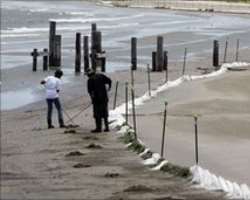BP EXTENDS TESTING OF CAPPED OIL WELL IN GULF OF MEXICO

Testing of BP's newly capped Gulf of Mexico oil well has been extended for a further 24 hours.
The US official in charge of the spill clean-up, Admiral Thad Allen, said the “integrity test” would not stop until Sunday afternoon.
He added that when the test ceased, containment of the spill using surface ships to collect oil would resume.
The new cap has managed to stop the flow of oil for the first time since the well exploded three months ago.
The flow of oil was shut off at 1425 local time (1925 GMT) on Thursday.
In a statement, Adm Allen said: “Based on the data and pressure readings compiled to date, the test has provided us with valuable information which will inform the procedure to kill the well and a better understanding of options for temporary shut-in during a hurricane.
“As we continue to see success in the temporary halt of oil from the leak, the US government and BP have agreed to allow the well integrity test to continue another 24 hours.”
He added that at the end of the test, the surface ships resuming collection of leaking oil would have the capacity to take up to 80,000 barrels per day.
Correspondents say this switch-over will see crude oil flowing into the Gulf once again, on temporary basis, as pressure is relieved.
BP is drilling relief wells which aim to intercept the leaking one at the end of July, enabling it to be sealed by mid-August.
Adm Allen's statement concluded: “Progress also continues on the two relief wells the federal government has required BP to drill. The relief well remains the ultimate step in stopping the BP oil leak for good.”
The spill has been described as the worst environmental disaster the US has ever seen.
Eleven workers were killed when the Deepwater Horizon rig blew up on 20 April.
The subsequent spill has affected hundreds of miles of Gulf coastline since April, with serious economic damage to the region as tourists have avoided Gulf Coast beaches and fishing grounds have remained closed.
BP has put the costs of dealing with the disaster at over $3.5bn (£2.3bn).
It has already paid out more than $200m to 32,000 claimants.
The company is evaluating a further 17,000 for payment and is seeking more information on 61,000 other claims.
–>
NEW CAP FOR LEAKING OIL WELL In June, BP placed a cap, known as an LMRP cap, over the top of the Deepwater Horizon well so oil could be collected at the surface. However, this continued to leak oil and has now been replaced with a better fitting device. NEW CAP FOR LEAKING OIL WELL When engineers removed the LMRP cap on 10 July, oil began to freely flow from the top of the blowout preventer once more. However, the Q4000 containment system continued to take some oil to the surface. NEW CAP FOR LEAKING OIL WELL Engineers then bolted on a new capping stack onto the blowout preventer (BOP). This allowed them to conduct a series of tests to see if the flow of oil could be stopped using the newly installed equipment. NEW CAP FOR LEAKING OIL WELL During the test the three ram capping stack has been closed and all sub-sea containment systems collecting the oil temporarily suspended, effectively blocking the flow of oil from the well. NEW CAP FOR LEAKING OIL WELL Once the tests have been successfully completed, BP will resume collecting oil. The Helix Producer ship was recently connected to the BOP to provide another collection route in addition to the Q4000 rig.
